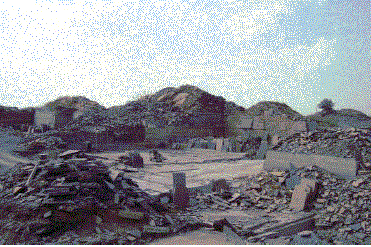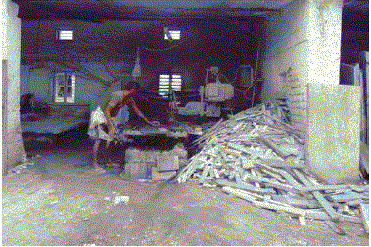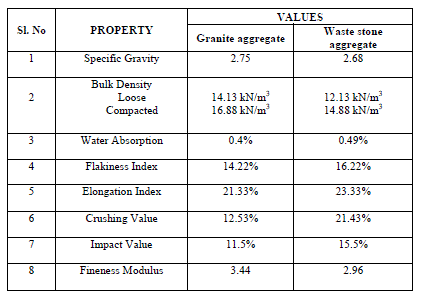ISSN ONLINE(2319-8753)PRINT(2347-6710)
ISSN ONLINE(2319-8753)PRINT(2347-6710)
N.Venkata Ramana1, C.Sashidhar2, S.Subba Reddy3, S.Vinay Babu4
|
| Related article at Pubmed, Scholar Google |
Visit for more related articles at International Journal of Innovative Research in Science, Engineering and Technology
In general the construction works are building with reinforced cement concrete (RCC) material. The Cement concrete is composition of cement, coarse and fine aggregate, water and some admixtures. For many works the coarse aggregate is brought from granite stone. Geographically the Tadpatri, Anantapur (Dist), Andhra Pradesh (State) is much potential to layered stone (Kadapa slab). The layered stone is utilizing for roof and floor works. During processing of finished product, waste is generating and this waste is dumping in and around the town (Tadpatri).The paper presents the feasibility of utilization of stone waste for construction works. The primary lab tests showed the potentiality of waste for construction.
Keywords |
| Waste stone aggregate, granite aggregate, physical and chemical properties |
INTRODUCTION |
| Solid waste management is a fundamental component to any manufacturing or production enterprise. The natural stone industry is unique in that the majority of its solid waste stream is its raw material, often in unadulterated form. Waste from quarry and fabrication operations can be unsafe and environmentally detrimental. Scrap stone can create an undesirable visual impact as well as dangerous working conditions, if it is not well organized or if piles are allowed to be stacked carelessly. Runoff from the scrap mounds can cause erosion problems, and fines introduced into natural waterways can suffocate local ecosystems. Further, if waste must be disposed of off-site, landfill fees can create additional costs for quarry and fabrication operators. From the past and present construction industrialization sector it is known that, the growth urbanization increase in consumption on natural material and have led to fast decline in available natural resources. On the other hand high volume of production has generated a considerable amount of waste materials which have adverse impact on the environment. Marble and granite aggregates, which are called as by-products come from the marble and granite stone industries. In this concern state of art is presenting below Mustafs Karasshin and Serdal Terzi [2007] were conducted the studies on marble waste. The marble waste was used in asphalt mixtures as filler material. The study showed that marble waste is effective for asphalt works and is also it over all cost is minimized. Hankfi Binci et.al.[2008] reported the concrete behaviour made with aggregate of marble waste, granite and ground blast furnace slag(GBFS).They reported in their investigation as the utilization of marble, granite and GBFS in the concrete mix enhances the mechanical properties. Kursat Esat Alyamac and Ragip Ince [2009] studied the marble powder utilization in self compacting concrete (SSC), from their investigation, it is observed that the marble powder can be effectively used to improve the fresh and harden concrete properties. Bahar Demirel [2010] has conducted the experimental work on concrete. In his work the waste marble dust (WMD) was used as replacement for sand. From his work it is observed that the usage WMD is enhances the compressive strength.Nagabhushna and Sharada bai [2011] reported the behaviour of concrete produced with crushed rock powder as replacement to fine aggregate. They observed that the replacement is possible up to 40% without reduction of concrete strength. Based on the recent past literature it is observed that much of work has been focused on marble powder, little work has carried on marble or stone waste. In this view as resident near to Tadapatri (town), the authors have made an attempt on utilization of the waste marble for construction works. In the coming section the introduction to marble waste and methodology to observe the potentiality of waste for constriction works is presented. |
IDENTIFICATION OF THE PROBLEM |
| The Anatapur, Kurnool and Kadapa district areas of Andhra Pradesh (state) are much potential for natural black stone. In these areas the layered stone are exploring form the quarry (Fig.1) and making into finished goods for flooring and ornamental purpose (Fig.2). During this stage of converting into finished goods the waste is generating and this is dumping in and around the stone industry and road side (Fig.3). It is causing to inconvenience to the peoples who are residing near the industry and beside the road. |
 |
| Tadpatri is a town in Anatapur (Dist), which is having about 1300 stone polishing and 300 granite industries, from these industries around 20,000 peoples are benefited directly and indirectly. It is well known place for producing black stone and granite polishing in Anantapur (Dist).The lime stone reserves are extending from Tadipatri(Anantapur(Dist)) to Kamalapuram (Kadapa(Dist)) and yerraguntla to Bethamcherla in Kurnool district. |
| Statistical data of waste generation from polishing industries. (This was obtained from the owners of industries) |
| One tractor carrying capacity to bring rough stone for polishing =1200 Sq.ft. |
| Damage during transportation =50 Sq.ft. |
| Finished product from 6 polishing machines =1200 to 1500 Sq.ft. |
| Waste generation during finishing of lime stone slab =150 to 200 Sq.ft. |
| Total number of factories =1300 |
| Waste generation (if 150Sq.ft consider) =1300X150=195000 Sq.ft |
| Waste generation (if 200 Sq.ft consider) =1300X200=260000Sq.ft |
| From the above data is observed that daily around 162 to 217 tractors are disposing the waste in and around the town. This leads a big headache to the local peoples. By knowing this data and disposal problem, the authors are planned to eradicate this disposal problem (up to some extent) and preserve the original resources of aggregate for future generation. |
FEASIBLE SOLUTION |
| The waste stone was brought from polishing industry to crusher unit and made in to 20mm aggregate (Fig.4). To know the physical and chemical properties the obtained 20mm aggregate (Fig.5) is tested in the laboratory. For comparison of physical properties the granite aggregate is taken into consideration (Fig.6). The obtained properties are presented in Table. I and II. From these tables it is observed that the waste stone aggregate is not so inferior when compared that natural granite aggregate. The authors were felt that it may use for civil works and to ascertain the statement it need to do some more strength (compressive, split flexural, torsion etc) and durability tests. |
CONCLUSION |
| From the test results it is concluded that there is a feasibility to utilize the waste aggregate for minor works at initial states. So that the disposal problem can be eradicate up to some extent and also save the granite aggregate for future generation. |
 |
 |
References |
|